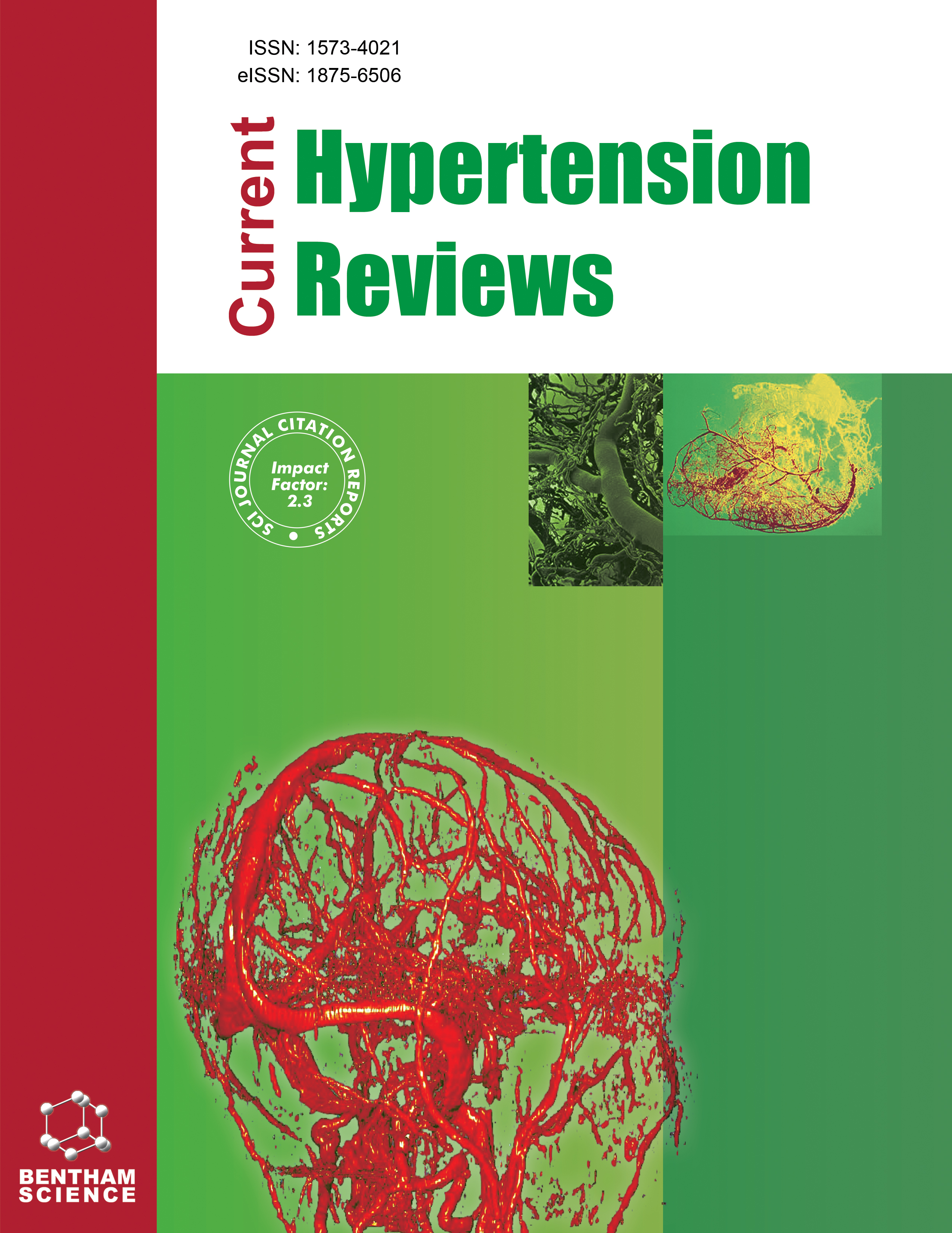- Home
- A-Z Publications
- Current Hypertension Reviews
- Previous Issues
- Volume 17, Issue 3, 2021
Current Hypertension Reviews - Volume 17, Issue 3, 2021
Volume 17, Issue 3, 2021
-
-
Anti-Hypertensive Potential and Epigenetics of Angiotensin II type 2 Receptor (AT2R)
More LessBackground: Renin angiotensin system (RAS) is a critical pathway involved in blood pressure regulation. Octapeptide, angiotensin II (Ang II), is a biologically active compound of RAS pathway which mediates its action by binding to either angiotensin II type 1 receptor (AT1R) or angiotensin II type 2 receptor (AT2R). Binding of Ang II to AT1R facilitates blood pressure regulation, whereas AT2R is primarily involved in wound heali Read More
-
-
-
Whole Milk and Full-Fat Dairy Products and Hypertensive Risks
More LessAuthors: Stephen J. Roy and Hirofumi TanakaLifestyle modifications in the form of diet and exercise are generally the first-line approach to reduce hypertensive risk and overall cardiovascular disease (CVD) risk. Accumulating research evidence has revealed that consumption of non- and low-fat dairy products incorporated into the routine diet is an effective means to reduce elevated blood pressure and improve vascular functions. However, the idea of incorporating whole- Read More
-
-
-
Beta Blockers and Chronic Obstructive Pulmonary Disease (COPD): Sum of Evidence
More LessAuthors: Katerina Baou, Vasiliki Katsi, Thomas Makris and Dimitris TousoulisApproximately half a century has passed since the discovery of beta-blockers. Then, their prime therapeutic purpose was to treat angina and cardiac arrhythmias; nowadays, beta-blockers’ usage and effectiveness are extended to treat other cardiovascular diseases, such as hypertension, congestive heart failure, and coronary artery disease. Safety concerns were raised about beta- blockers and their use for chronic obstru Read More
-
-
-
Angiotensin-Converting Enzyme 2 Roles in the Pathogenesis of COVID-19
More LessThe new pandemic Coronavirus Disease 2019 (COVID-19) causes a wide range of clinical consequences, from asymptomatic infection to acute respiratory failure, and it is very heterogeneous. The renin-angiotensin system (RAS) is well recognized as a key regulating system in circulatory homeostasis that plays prominent roles in pathophysiological processes in abnormal activation, for instance, renal and cardiovascular di Read More
-
-
-
Evaluating the Safety and Tolerability of Azilsartan Medoxomil Alone or in Combination With Chlorthalidone in the Management of Hypertension: A Systematic Review
More LessBackground: Azilsartan medoxomil (AZM) is the newest representative in the class of angiotensin receptor blockers. Azilsartan medoxomil in combination with the older diuretic chlorthalidone (CLD) in fixed-doses of AZM/CLD 40/12.5 mg and 40/25 mg has been approved by the FDA for use in patients with essential hypertension. We sought to evaluate the safety and tolerability of AZL-M alone and in combination with CL Read More
-
-
-
Serum Uric Acid and Progression of Autosomal Dominant Polycystic Kidney Disease: Results from the HALT PKD Trials
More LessAuthors: Godela M. Brosnahan, Zhiying You, Wei Wang, Berenice Y. Gitomer and Michel ChoncholBackground: Epidemiological studies have suggested that elevated serum uric acid may contribute to the progression of chronic kidney disease. However, no large prospective study has examined whether hyperuricemia is an independent risk factor for the progression of autosomal dominant polycystic kidney disease (ADPKD). Methods: We measured uric acid in stored serum samples from the 2-year study visit of 671 particip Read More
-
-
-
A Nested Case-Control Study of Serum Fasting Lipid Profiles in Pre- Eclamptic Primigravidas in Ile-Ife, Nigeria
More LessBackground: Pre-eclampsia contributes significantly to both maternal and perinatal morbidities and mortalities. One of the identified pathophysiologies of pre-eclampsia is the deranged serum lipid profile of which some components have been found to be elevated early in pregnancy in women destined to develop pre-eclampsia. Objectives: To compare the serum fasting lipid profiles of pre-eclamptic primigr Read More
-
-
-
Association of Low BMI with Aortic Stiffness in Young Healthy Individuals
More LessAuthors: Satish G. Patil, Sneha Arakeri and Vitthal KhodeBackground: Increased arterial stiffness is an independent predictor of cardiovascular morbidity and mortality. It is unknown whether low BMI has any detrimental effect on the arterial wall during young age. Objectives: The present study was aimed to determine if low BMI can increase arterial stiffness in young, healthy individuals. Methods: A cross-sectional study was conducted on young, healthy subjects (n=100) with low BMI Read More
-
Volumes & issues
-
Volume 21 (2025)
-
Volume 20 (2024)
-
Volume 19 (2023)
-
Volume 18 (2022)
-
Volume 17 (2021)
-
Volume 16 (2020)
-
Volume 15 (2019)
-
Volume 14 (2018)
-
Volume 13 (2017)
-
Volume 12 (2016)
-
Volume 11 (2015)
-
Volume 10 (2014)
-
Volume 9 (2013)
-
Volume 8 (2012)
-
Volume 7 (2011)
-
Volume 6 (2010)
-
Volume 5 (2009)
-
Volume 4 (2008)
-
Volume 3 (2007)
-
Volume 2 (2006)
-
Volume 1 (2005)
Most Read This Month
Article
content/journals/chyr
Journal
10
5
false
en


